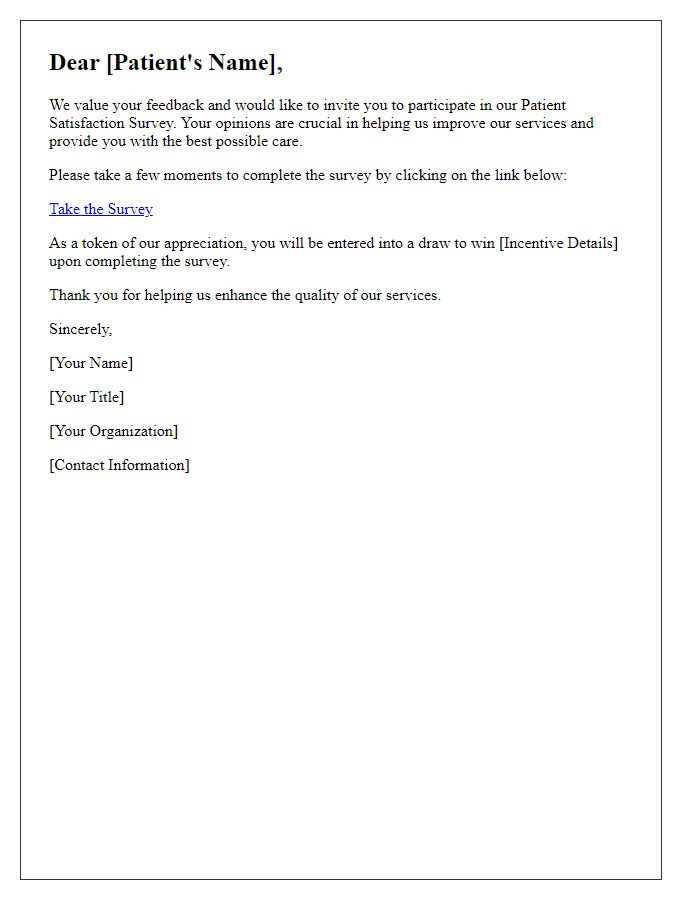Are you curious about how well your healthcare provider is meeting your needs? Understanding patient satisfaction is key to improving medical services and ensuring you receive the best care possible. We invite you to share your thoughts through our patient satisfaction survey, designed to gather your valuable feedback. Join us in making healthcare better for everyoneâread on to learn more about the survey and how your input can make a difference!

Clear Objective Statement
A patient satisfaction survey aims to evaluate and enhance the quality of care provided at healthcare facilities such as hospitals or clinics. This survey collects feedback on various aspects including medical staff responsiveness, cleanliness of facilities, and the effectiveness of treatment received. Analyzing responses assists in identifying strengths and areas for improvement, ensuring that patient experiences are prioritized. Insights gained from this survey contribute to improving healthcare services, fostering a patient-centered atmosphere, and ultimately elevating overall health outcomes in communities.
Personalization Elements
Patient satisfaction surveys are vital tools for healthcare facilities, providing critical insights into service quality and patient experience. Tailored questions, such as "Rate the friendliness of the staff you interacted with during your visit to St. Mary's Hospital," help to gather specific feedback on interpersonal interactions. Including metrics like appointment wait times, which can average 30 minutes at clinics, alongside personal reflections on comfort levels during procedures, such as a colonoscopy, offers a comprehensive developmental perspective. Furthermore, asking about the cleanliness standards observed, particularly in high-traffic areas like the emergency room, ensures that the facility's hygiene practices are scrutinized. Collecting demographic data, such as age and length of stay, alongside patient comments fosters a richer understanding of the satisfaction levels across various patient segments.
Simple and Direct Questions
User-friendly patient satisfaction surveys facilitate constructive feedback from individuals receiving medical care. Surveys should include straightforward inquiries such as "How would you rate your overall experience at [Healthcare Facility Name]?" which allows patients to provide a comprehensive evaluation. Another essential question involves the assessment of staff interaction, like "Were the medical staff courteous and attentive during your visit?" This encourages patients to reflect on their engagement. Additionally, probing into appointment scheduling, such as "Was it easy to schedule your appointment?" provides insight into operational efficiency. Collecting data on facility cleanliness, with the question "Was the environment clean and comfortable?" ensures attention to hygiene standards. Lastly, asking for comments or suggestions creates an open channel for continuous improvement.
Confidentiality Assurance
Patient satisfaction surveys, often conducted in healthcare facilities such as hospitals or clinics, play a crucial role in evaluating the quality of care provided to patients. These surveys ensure confidentiality (the ethical principle of keeping patient information private), encouraging honest feedback. Responses are statistically analyzed to enhance patient experience rather than individual identification. For instance, data collected in 2023 from such surveys can pinpoint areas needing improvement, such as communication or service timeliness. Ensuring data anonymization reinforces trust, allowing patients to contribute without fearing repercussions, ultimately leading to better healthcare outcomes.
Easy Response Instructions
Patient satisfaction surveys play a crucial role in assessing healthcare services. Simple response instructions enhance participation rates and data accuracy. Clear guidance on how to complete the survey, using numbers (1 to 5 scale), allows patients to evaluate their experiences regarding staff interaction, wait times, and treatment effectiveness. Accessible formats, such as online platforms or printed questionnaires, cater to diverse patient demographics. Brief explanations for each question promote understanding, ensuring reliable feedback. Timely follow-ups encourage completion, thereby improving the overall response rate and enriching the data collected for continuous healthcare improvement.













Comments